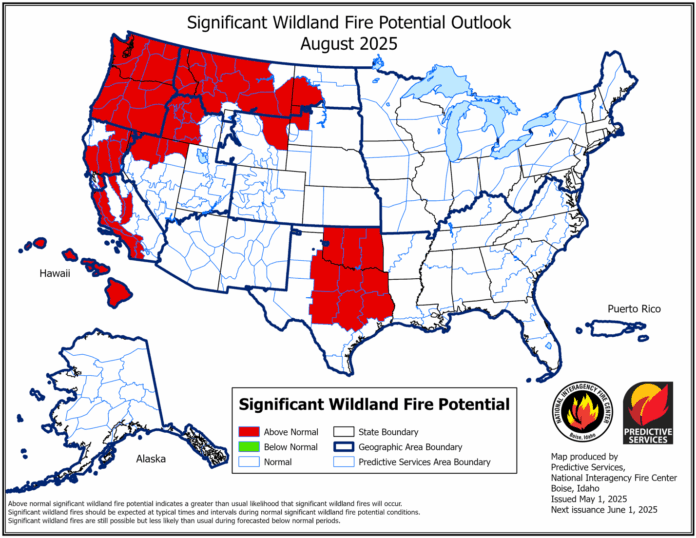
Local Firefighters Urge Vigilance As Questions Linger About Federal Support
By Mark Dee
Last summer, Idaho lost more acreage to wildfire than in any year since 2007. This year, preliminary forecasts call for similar conditions in the months ahead.
Models from the National Oceanic and Atmospheric Administration’s Climate Prediction Center call for an above average chance of hotter-than-normal temperatures and lower than usual precipitation totals. That, coupled with an analysis of the last winter’s weather and on-the-ground vegetation, led the forecasters at the National Interagency Fire Center to anticipate above-average fire risk spreading into Idaho this July and, especially, August.
“For July and August, concern shifts northward to northern Nevada and Idaho,” the center stated in its May 1 outlook. “Fine fuel carryover is expected to be above normal in the lower elevations. Meanwhile, despite the healthy winter snowfall, forecast prolonged warm and dry conditions will bring the higher elevations of Idaho into play by August, with above normal potential forecast.”
The next forecast is scheduled for June 1.
Between the weather and fuels, Ketchum Assistant Fire Chief Seth Martin expects conditions “to be similar” to 2024. Nearly 1 million acres burned across the Idaho last season, accounting for about one ninth of all land burned in the United States in 2024. By pure acreage, that statistic makes last year Idaho’s worst fire season since 2007, when the Murphy Complex Fire, Idaho’s largest since 1910, burned close to half a million acres by itself near the Nevada border.
Locally, the impact was hard to ignore. The Wapiti Fire, which lightning sparked near Grandjean on July 24, burned more than 125,000 acres before it was contained on Halloween, casting a smoky pall on Stanley’s summer. While much smaller, the human caused Bench Lakes Fire was just as visible, burning through the popular hiking destination near Redfish Lake and, eventually, down to the shores of the lake itself.
Martin isn’t in the business of forecasting fires, but he isn’t surprised by the prevailing outlook.
“It’s been proven for many years that the climate is getting hotter and drier,” he said, “and a hotter and drier climate makes fires bigger and faster.”
Ketchum Fire is looking to hire an engine boss to run its wildland apparatus, but is otherwise fully staffed, Martin said.
Martin reiterated that all of the area’s mutual aid agreements, which promise that local and federal agencies help across jurisdictional bounds, remain intact.
Less clear is how that help will look as federal employees reel from a winter of staff cuts following President Donald Trump’s suite of executive orders aimed at paring the government’s workforce. Trump’s orders spared public safety staff, including wildland firefighters, but slashed many supporting roles. About 10% of U.S. Forest Service employees lost their jobs in February, according to ProPublica, along with 8% of Bureau of Land Management employees, according to the National Resources Defense Council, a conservation advocacy group.
About 75% of Forest Service employees are trained in wildland firefighting, working on the frontlines, ProPublica reported, with others providing support during a fire. Other employees are tasked with preventative work in fire-prone areas, like thinning and executing controlled burns.
By press time, Forest Service had not responded to questions about its firefighting capacity on the Sawtooth National Forest, or what preparations were underway on Forest Service land. Martin, whose jurisdiction is largely surrounded by that national forest, did not comment on questions of federal support this summer.
Further south, Wood River Fire and Rescue Fire Marshal Mike Elle told the Wood River Weekly that “BLM equipment is fully staffed at all stations and deployment yards. Aircraft usually come online June 1, Elle said, though he expects some support to be ready sooner.
“We do almost all of our response work with the BLM,” he said, “so that is our biggest concern in the south end of the Wood River Valley.”
Firefighters: Prepare Your Home For Fire Season
Both Elle and Martin asked homeowners to use the springtime to get their properties ready for the summer ahead. Every city in the Wood River Valley sits in what the U.S. Fire Administration calls the Wildland-Urban Interface, where manmade structures like homes meet undeveloped vegetation—fuel for fire, Martin said. These areas are most prone to destructive, sometimes deadly, wildfires.
At minimum, both firefighters emphasize creating a “defensible space” around buildings by thinning vegetation, clearing deadfall, pruning low-hanging branches and ensuring you have a 20-foot-wide driveway clear of overhead obstructions that can accommodate fire trucks.
Elle suggests going further to make your home “survivable” during a wildfire. Defensible spaces allow firefighters to get between a building and an encroaching blaze. A “survivable home” can withstand a fire on its own.
“Fire Departments in this county do not have enough fire engines or firefighters to protect every single home from an approaching wildfire, so making a home ‘survivable’ means a wildfire can burn around your home without setting it on fire and without firefighters there to protect it,” Elle said. “Once a wildland fire passes by an area, fire engines then patrol the area looking for hot spots or embers that possibly start another fire.”
For more information, including a checklist of ways to secure your property, Elle recommends go to www.firewise.org.


